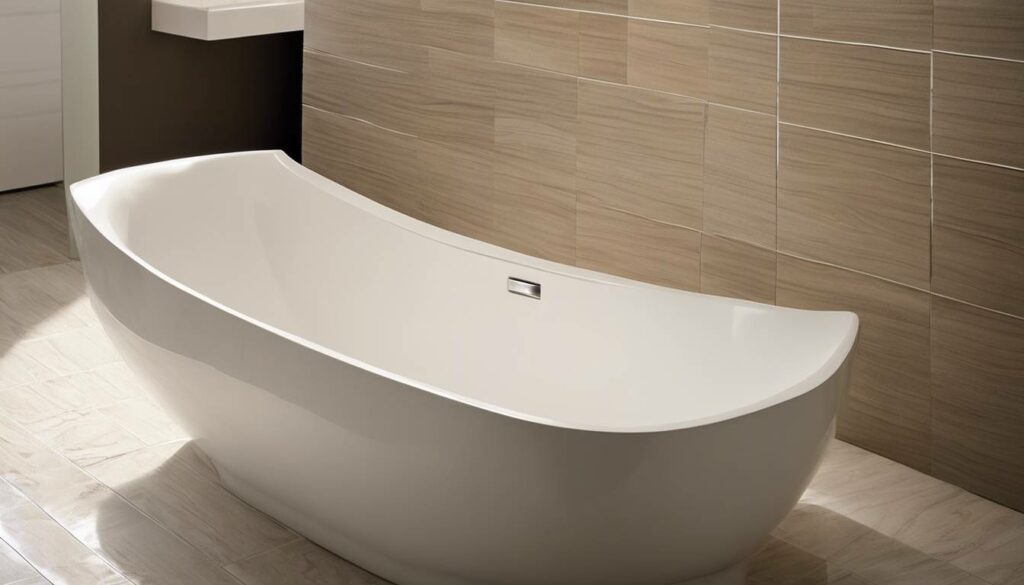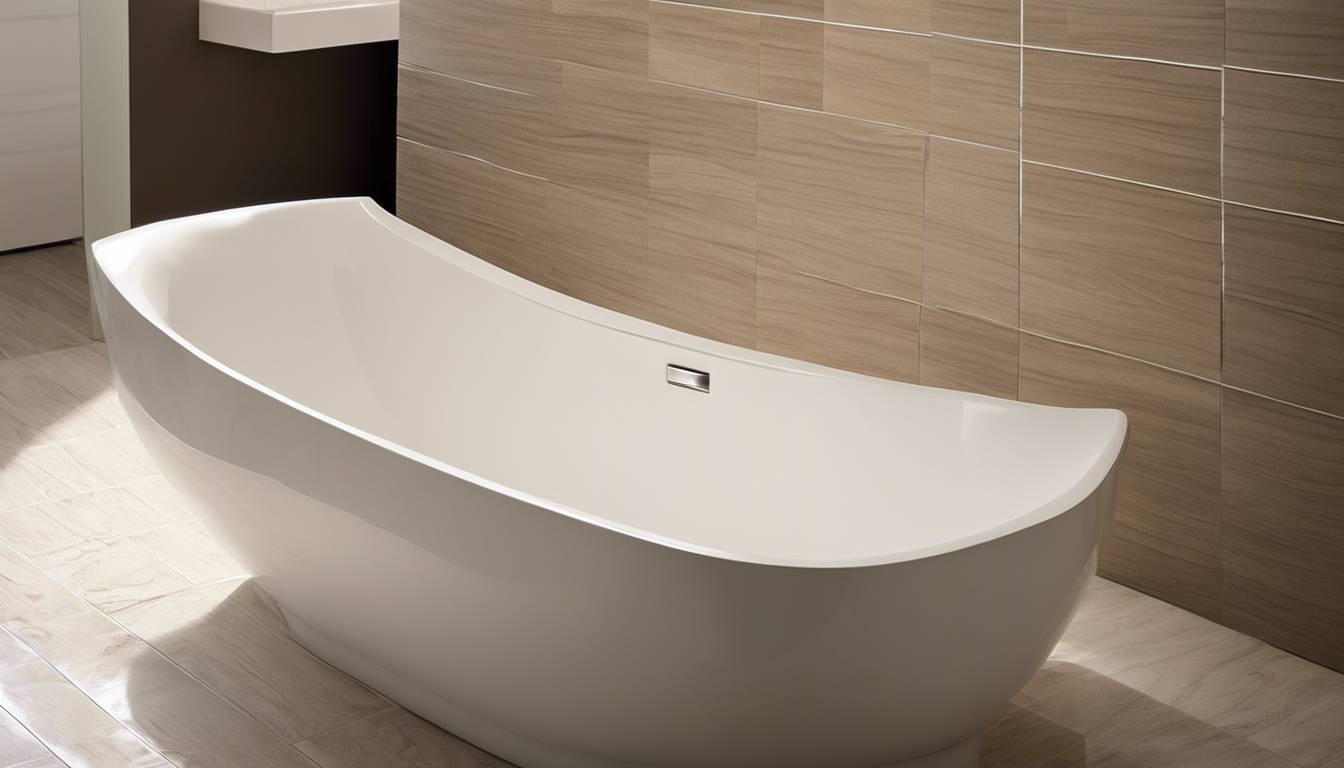Key players in the tub game are acrylic, steel, glass, and certain petrochemical products. Each excels in its own way, offering unique benefits with specific maintenance needs. But making a wise choice depends not just on durability or aesthetics, but also on your personal capacity to upkeep whatever material you opt for. Dealing with dingy acrylic is much different than tending to tarnished steel or grimy glass. And now, let’s get into it.
When it comes to bathtub materials, options such as fiberglass, porcelain-enameled steel, enamel-coated cast iron, and acrylic are popular choices. To clean these materials, a simple routine of using hot water, dish soap, baking soda, and a scrub brush can effectively remove dirt and grime. For tougher issues like mold or mildew, a solution of hot water and bleach can be used in conjunction with regular cleaning steps. In some cases, you might need to tackle specific problems like removing hair dye stains from your bathtub. Always refer to the manufacturer’s guidelines for specific cleaning instructions based on the bathtub material.
Top Bathtub Materials
When it comes to selecting a bathtub, various materials should be considered, each with unique properties, benefits, and maintenance needs. These materials encompass acrylic, steel, glass, and petrochemical options.
Acrylic
Acrylic is a popular choice for bathtubs due to its affordability, light weight, and versatile design options. It boasts a high-gloss finish that presents a modern and sleek appearance. Moreover, this material is durable and easy to clean, making it appealing for homeowners. However, despite its advantages, acrylic bathtubs are prone to scratches and require careful cleaning to avoid damage from harsh or abrasive products over time.
Steel
Steel bathtubs are renowned for their durability and innate heat retention, ensuring bathwater stays warm for extended periods. Their porcelain coating provides a glossy and smooth texture while offering protection against stains and discoloration. However, steel bathtubs are susceptible to chips and rust, necessitating prompt attention to prevent further damage.
Glass
Glass bathtubs exude elegance and luxury, often considered a high-end option owing to their aesthetic appeal. Crafted from reinforced glass, they boast incredible sturdiness and scratch resistance. While the transparency of glass makes dirt and grime easily detectable for thorough cleaning, frequent wiping is required to maintain its pristine appearance.
Petrochemical Options
Petrochemical options such as fiberglass represent a cost-effective and lightweight alternative sought after for remodeling projects due to their ease of installation. However, they may not offer the same level of durability as other materials and could be prone to cracking or fading if not properly maintained over time.
The selection of bathtub material significantly impacts your bathing experience and the overall aesthetics of your bathroom. Carefully weigh the pros and cons of each material based on personal preferences, budget constraints, and long-term maintenance capabilities before making a decision.
As we navigate through the myriad of bathtub materials, let’s now turn our attention to the care and maintenance specifics of acrylic tubs—the ideal choice for many homeowners.
Acrylic Care and Cleaning
Acrylic bathtubs are a popular choice in modern homes for their sleek look and easy maintenance. However, keeping them in top condition requires special attention to ensure their longevity. Here are some expert tips on caring for and cleaning acrylic bathtubs.
Gentle Cleaning
Acrylic surfaces are sensitive to harsh cleaning agents and abrasive materials. To preserve the integrity of the material, it’s crucial to use a non-abrasive, mild detergent and a soft cloth for regular cleaning. Avoid using rough or gritty sponges, as they can scratch or damage the surface. It’s like giving your bathtub a gentle spa treatment—soft, soothing care to maintain its beauty.
When you clean your acrylic bathtub, make sure to use a soft sponge or microfiber cloth. These materials will help prevent scratches on the delicate surface. Just like how a gentle touch can make your skin glow, a gentle cleaning routine can keep your bathtub looking as good as new.
Avoid Harsh Chemicals
It’s important to steer clear of abrasive cleaners, bleach, acetone, or strong solvents when cleaning an acrylic bathtub. Using these harsh chemicals can cause permanent damage to the acrylic finish, leading to discoloration or loss of shine. Instead, opt for gentle cleaning solutions that are specifically formulated for use on acrylic surfaces.
Acrylic is like a delicate flower that needs nurturing and care. Using harsh chemicals on it is akin to subjecting the flower to extreme conditions—it withers away instead of thriving.
Product Recommendation
As an affiliate site dedicated to home decor, it’s valuable to recommend specific and reputable acrylic-friendly bathtub cleaners available for purchase. For a natural cleaning solution, you might consider using baking soda and vinegar for your bathtub maintenance. By providing your audience with product recommendations, you not only offer them convenient access to quality cleaning solutions but also establish trust by guiding them towards reliable products that align with their needs.
Consider featuring well-reviewed acrylic-safe cleaners that have received positive feedback from consumers. For instance, products that are formulated specifically for acrylic tubs and offer effective yet gentle cleaning properties would be ideal recommendations.
A high-quality tub cleaner might be likened to finding the perfect skincare product that suits your skin type—it nourishes and revitalizes without causing any harm.
Caring for an acrylic bathtub involves using the right tools and products while avoiding damaging materials at all costs. With these precautions in mind and proper maintenance practices, you can ensure that your acrylic bathtub retains its shine and durability for years to come.
Moving from understanding how to take care of an acrylic tub, let’s shift our focus to exploring effective strategies for maintaining the steel tub’s pristine condition.
Steel Tub Cleaning Tips
Steel tubs offer durability and a sleek, modern look, making them a popular choice for many homes. However, maintaining the pristine appearance of a steel bathtub requires specific care to prevent rust and keep it clean without damaging the surface.
Rust Prevention
Preventing rust in a steel tub is vital to ensuring its longevity and appearance. One effective way to achieve this is by keeping the surface dry after each use. Moisture accumulation can accelerate the formation of rust. After drying the tub, applying a thin layer of car wax can create a protective barrier against moisture, enhancing the tub’s resistance to rust. This simple step can significantly extend the lifespan of your steel tub.
Imagine the car wax acting as a shield, protecting the surface of your steel tub from the elements. Just as you would care for the exterior of your car to prevent rust, treating your steel tub with car wax plays a similar role in safeguarding it against moisture-induced corrosion.
Regular Maintenance
When it comes to cleaning steel tubs, using a mild, non-abrasive cleaner is crucial. Abrasive cleaners can scratch or even remove the enamel coating, compromising both the appearance and integrity of the tub. Avoid harsh scrubbing that can damage the surface, opting instead for gentle yet effective cleaning methods.
By prioritizing regular maintenance with appropriate cleaning solutions, such as pH-neutral cleaners, you can effectively remove dirt and stains without compromising the finish of your steel tub. Additionally, using a soft sponge or cloth for cleaning will help prevent any accidental scratches, preserving the smooth and glossy appearance of the tub for years to come.
Taking these preventive measures and adopting gentle cleaning practices are essential in ensuring that your steel tub not only remains free from rust but also retains its pristine appearance over time.
Glass Tub Maintenance
Glass bathtubs add a touch of elegance to any bathroom—they are sleek, modern, and beautiful. But with great beauty comes great responsibility, and glass bathtubs require careful maintenance to keep their shine. The same principles apply when you need to clean shower tiles without scrubbing, which can be particularly useful for glass surfaces.
To keep your glass bathtub looking pristine, it’s important to squeegee it after each use. This simple step can prevent water spots and soap scum buildup. Just as you squeegee your windows to get rid of streaks after washing them, doing the same for your glass bathtub will keep it sparkling clean.
Moreover, using the right cleaners is essential for maintaining a glass bathtub’s shine. Opt for gentle, non-abrasive cleaners that are designed specifically for glass surfaces. Harsh ingredients in some cleaning products can leave streaks or even damage the glass, so be sure to choose a product that is specially formulated for use on glass materials.
- Example: For example, a mixture of 1 part white vinegar to 3 parts water is an effective and safe cleaning solution for glass tubs. This not only helps to remove soap scum and hard water stains but also ensures that your glass tub remains spotless and elegant.
Some may argue that cleaning a glass tub after every use seems like overkill, but when you consider how easily soap scum and hard water marks can mar the appearance of the glass surface, it becomes evident that regular upkeep is necessary to maintain its beauty.
Here are practical guidelines to ensure that your glass bathtub preserves its luxurious appearance day after day.
Petrochemical Tub Upkeep
Petrochemical tubs are esteemed for their outstanding resistance to chemical corrosion, making them a durable and low-maintenance choice. This inherent trait allows you to use an array of cleaning products without worrying about causing any damage to the material.
The chemical resistance of petrochemical tubs means you can confidently use a variety of cleaners to tackle common bathroom grime and buildup. Whether it’s soap scum, mineral deposits, or water stains, you can rely on the robust nature of petrochemical tubs to withstand regular cleaning without any adverse effects.
When it comes to maintaining the gleaming quality of petrochemical tubs, mild cleansers are your best friend. These gentler cleaning solutions are effective in preserving the pristine condition of the tub. Not only do they help in keeping the tub looking impeccable, but they also play a vital role in preventing any potential damage from harsher cleaners that may be excessive for the job at hand.
Using mild cleansers for regular upkeep ensures that the petrochemical tub remains in optimal condition for years to come. These gentle cleaning products effectively remove dirt, grime, and soap residue without risking any harm to the surface. By incorporating mild cleansers into your regular cleaning routine, you can maintain the lustrous appearance of the petrochemical tub while proactively safeguarding its longevity.
With a petrochemical tub’s impressive chemical resistance and the effectiveness of mild cleaners for regular maintenance, it’s clear that this type of bathtub offers both durability and ease when it comes to keeping it clean and looking as good as new.
The key to preserving your bathtub’s pristine condition doesn’t end with just cleaning; preventing tough stains is equally essential. Now, let’s delve into effective strategies for keeping your bathtub stain-free.
Tub Stain Prevention
Nobody likes discovering unsightly stains in their bathtub. They can be stubborn and difficult to remove if left unattended. So, what can we do to prevent these stubborn stains from ruining the pristine look of our bathtubs? Here are some effective strategies that can help you maintain a clean and spotless tub.
Regular Cleaning Routine
A consistent cleaning routine is fundamental in warding off the buildup of dirt, soap scum, and mineral deposits inside your bathtub. Regular cleaning not only helps in preventing the formation of stubborn stains but also maintains the overall hygiene of your tub. This is especially important for ceramic surfaces, which are common in many bathrooms.
Just picture this: every time you take a bath, a small amount of grime, residual soap, and hard water minerals cling to the surfaces of your tub. Over time, these deposits accumulate and form tough stains that become increasingly difficult to remove. This is why incorporating a regular cleaning schedule is crucial in combatting this gradual buildup.
Regularly scheduled cleaning can significantly reduce the likelihood of stubborn stains developing and make the cleaning process more manageable.
Protective Coatings
Another effective way to shield your bathtub from tough stains is by applying protective coatings or sealants. These products form a barrier that prevents dirt, grime, and other staining agents from adhering to the surface of your tub.
For example, an acrylic tub might benefit from the application of a polyurethane-based sealant, which forms a resilient layer over the acrylic surface. Porcelain-enameled steel tubs can also benefit from ceramic resin sealants that provide an additional layer of protection against staining agents.
By adding this extra layer of defense, you’re essentially providing an added shield against potential staining culprits, making it easier to maintain the cleanliness of your bathtub.
The combination of a consistent cleaning schedule and the application of protective coatings can effectively stave off persistent stains and streamline the maintenance process for your bathtub.






